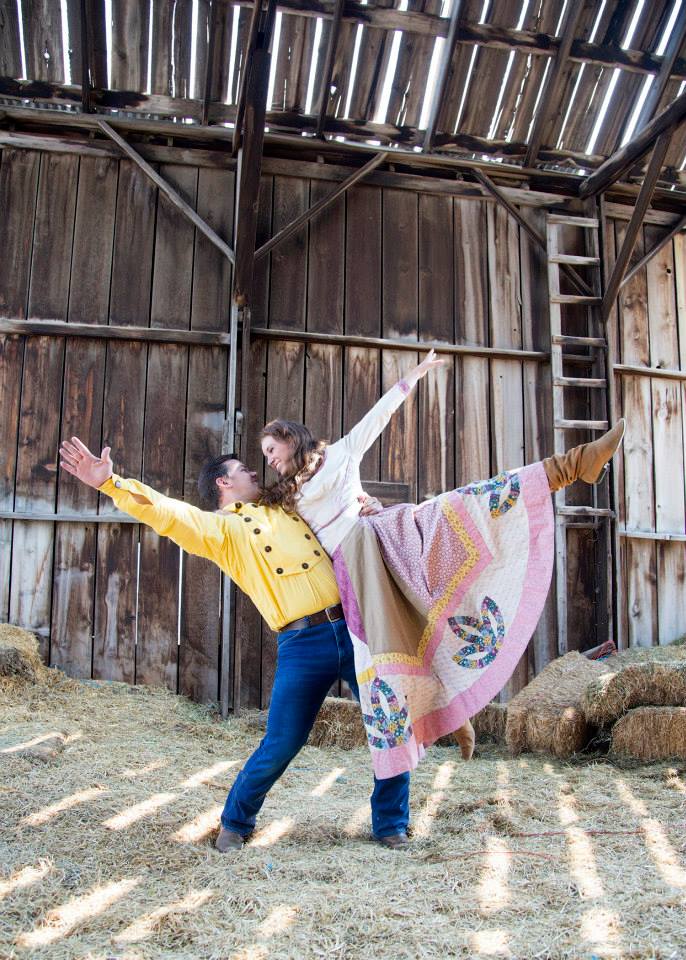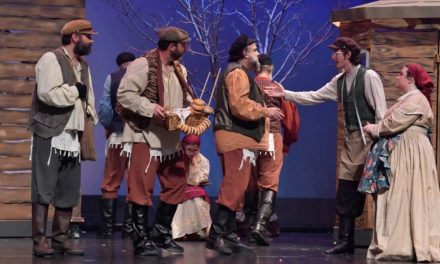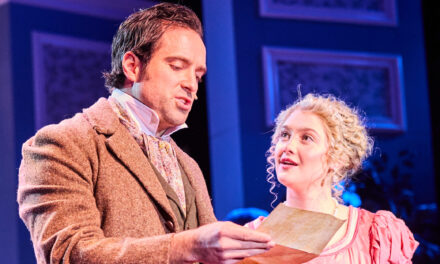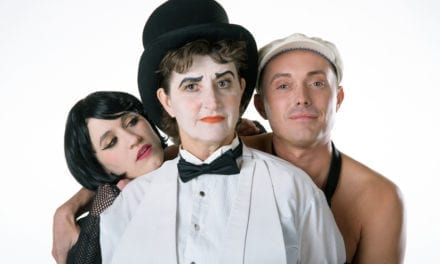OREM — “I only have to trick one person into marrying me.” That’s how in my years as a single man I would console myself when I felt lonely. Of course, I was joking, but in the musical Seven Brides for Seven Brothers the leading male character puts this attitude into action. The lighthearted attitude towards love in Lawrence Kasha and David Landay‘s script, coupled with the Gene de Paul‘s music and Johnny Mercer‘s lyrics (and additional songs by Al Kasha and Joel Hirschhorn), has pleased audiences for decades.
Seven Brides for Seven Brothers is based on the 1954 film of the same name, which in turn is based on a short story by Stephen Vincent Benet. In the musical Adam Pontipee, the oldest of seven brothers, comes to an 1800’s frontier town to find himself a wife. After a meeting and marrying Milly Bradon in the same day, he takes her home to his six younger brothers and expects Milly to cook and clean for all the family’s men. After Milly reforms them, the younger brothers then decide they too want to be “goin’ courtin'” in town so they can find their own wives.
Longtime SCERA director Jerry Elison helmed this show, and the result is a satisfying piece of theatre. Although the pacing of the first two scenes of the play was a little slow, the show soon picked up, starting in the scene when Milly and Adam have a conversation on their wedding night. The emotional connection between the two characters was sweet, and Jerry Elison ensured that the first fully honest conversation between Adam and Milly was difficult for both of them. Jerry Elison also created a fun scene in the brothers’ home when they are wearing only their blankets. By the end of the show I had a strong appreciation for the environment that Jerry Elison created.
 Like the direction, Penny Colvin‘s choreography in the first scene was flaccid. The dancing for the opening number mostly consisted of do-si-do’s, some skips, and the occasional kick. However, the choreography for each successive grew progressively more athletic and exciting until the finale—which was certainly worth the wait of sitting through the rest of the production. I also applaud Colvin’s choreography for the town social scene, which was constantly interesting to watch as the men of the town and the brothers attempted to woo the women. Colvin’s most successful numbers were infused with ballet moves, such as the “Lonely Polecat” dance.
Like the direction, Penny Colvin‘s choreography in the first scene was flaccid. The dancing for the opening number mostly consisted of do-si-do’s, some skips, and the occasional kick. However, the choreography for each successive grew progressively more athletic and exciting until the finale—which was certainly worth the wait of sitting through the rest of the production. I also applaud Colvin’s choreography for the town social scene, which was constantly interesting to watch as the men of the town and the brothers attempted to woo the women. Colvin’s most successful numbers were infused with ballet moves, such as the “Lonely Polecat” dance.
In the role of Millie Bradon, Kelly Cook had a folksy performance that matched the frontier setting of the play. Her “Goin’ Courtin'” was fun to watch as she weaved among the six younger brothers. The whole song, although a little hokey, was still pleasant because of Cook’s charisma and stage presence. Cook was also best in her one-on-one scenes with Mark Buffington, who played her stage husband Adam Pontipee. The two had a touching scene together at the trapping cabin, and the tenderness of the moment was clearly conveyed. However, I wish that Buffington’s song “Where Were You?” had a more varied delivery; the song instead seemed to consist of just one emotion, which became tedious to watch as the song progressed. Another enjoyable pair of performers were Tanner Wood as Gideon and Gwen Elison as Alice. The two had a bashful chemistry that made their interactions cute, especially when he takes her away to the cabin.
The strongest technical element of this production was Seth Mergist‘s lighting design. The back wall of the stage was always beautifully lit; Utahns will find the look of the sun behind the mountains well imitated by Mergist’s design. The winter scenes also had a fittingly gray and dreary look to them that matched the characters’ somber mood. Nat Reed‘s set design was cute, and the stylized trees that flanked the stage were a nice reminder that a musical based in the Old West shouldn’t be completely faithful to reality, but rather should take place in a gilded, idealized version of the 1800’s.
On the other hand, the sound (designed by audio engineer Douglas Olsen) was poor throughout the evening. I normally hesitate to criticize the sound of an amateur theatre company because the sound is the hardest technical element to get right, and many amateur companies don’t have the resources to have excellent sound design. However, the microphones malfunctioned, popped, or were turned too low so frequently that I had difficulty enjoying some of the scenes, such as the town social and “Bless Your Beautiful Hide.” The costumes (designed by Kelsey Seaver) were also disappointing because of the frequent use of modern pants, hats, and jackets (including some with zippers) that distracted from the setting that the director and others designers had so carefully cultivated. But Seaver did dress the brothers well for the social scene; as the brothers mingled—and fought— I could always quickly pick them out of the crowd because of their matching bright colored shirts (pictured below).
Overall, Seven Brides for Seven Brothers is a suitable evening of family entertainment. The SCERA Shell amphitheater is a wonderful setting for this play that mostly takes place outdoors. But, I hope audience members don’t learn a lesson from the Pontipee brothers and try to trick someone into marrying them as they’re goin’ courtin’.








